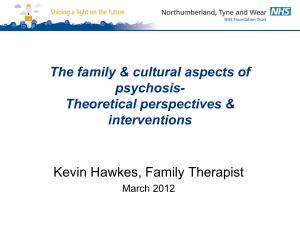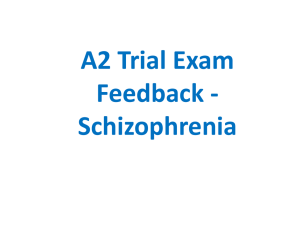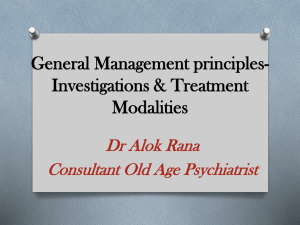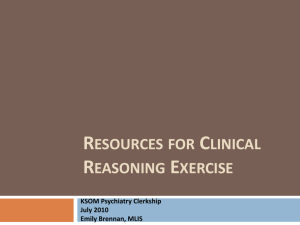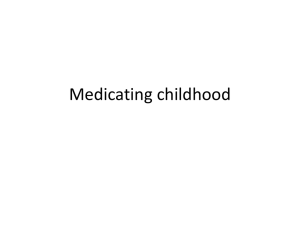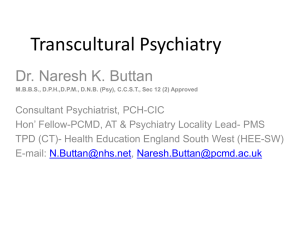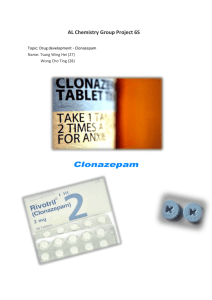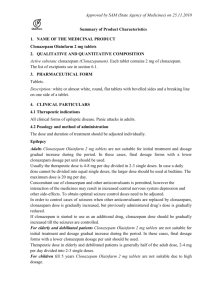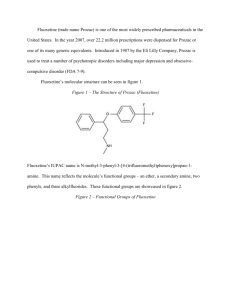Guy Chouinard, MD
advertisement
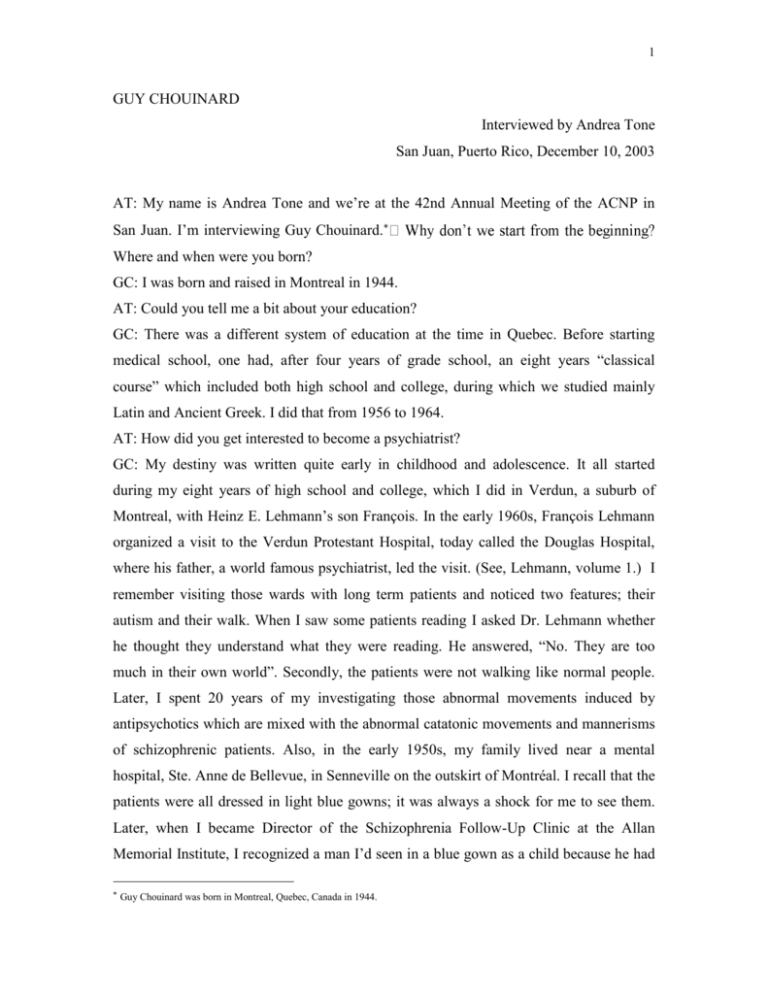
1 GUY CHOUINARD Interviewed by Andrea Tone San Juan, Puerto Rico, December 10, 2003 AT: My name is Andrea Tone and we’re at the 42nd Annual Meeting of the ACNP in San Juan. I’m interviewing Guy Chouinard. Where and when were you born? GC: I was born and raised in Montreal in 1944. AT: Could you tell me a bit about your education? GC: There was a different system of education at the time in Quebec. Before starting medical school, one had, after four years of grade school, an eight years “classical course” which included both high school and college, during which we studied mainly Latin and Ancient Greek. I did that from 1956 to 1964. AT: How did you get interested to become a psychiatrist? GC: My destiny was written quite early in childhood and adolescence. It all started during my eight years of high school and college, which I did in Verdun, a suburb of Montreal, with Heinz E. Lehmann’s son François. In the early 1960s, François Lehmann organized a visit to the Verdun Protestant Hospital, today called the Douglas Hospital, where his father, a world famous psychiatrist, led the visit. (See, Lehmann, volume 1.) I remember visiting those wards with long term patients and noticed two features; their autism and their walk. When I saw some patients reading I asked Dr. Lehmann whether he thought they understand what they were reading. He answered, “No. They are too much in their own world”. Secondly, the patients were not walking like normal people. Later, I spent 20 years of my investigating those abnormal movements induced by antipsychotics which are mixed with the abnormal catatonic movements and mannerisms of schizophrenic patients. Also, in the early 1950s, my family lived near a mental hospital, Ste. Anne de Bellevue, in Senneville on the outskirt of Montréal. I recall that the patients were all dressed in light blue gowns; it was always a shock for me to see them. Later, when I became Director of the Schizophrenia Follow-Up Clinic at the Allan Memorial Institute, I recognized a man I’d seen in a blue gown as a child because he had Guy Chouinard was born in Montreal, Quebec, Canada in 1944. 2 a small malformation of his lips but I never told him this during the many years I treated him. When I succeeded in his treatment with a new generation of atypical neuroleptics, he no longer looked like the person I used to see in that blue gown. AT: Why did they dress them like that? GC: Everyone was afraid of the mentally ill in those days. The hospital wanted them to be easily recognizable in the village; it was a modern mental hospital so the doors of the wards were open. AT: So, you always wanted to be a psychiatrist? GC: Initially, I was interested in both philosophy and medicine. My mother was ambivalent about philosophy; a bit concerned about earning a living. Then, I got more and more interested in medicine, and biological medicine became a passion, especially concerning the mysterious mental illnesses. I thought I would return to philosophy later in life, but by then, I had discovered molecular pharmacology and became fascinated by it. However, I kept an interest in philosophy, which in some ways drew me to psychiatry. Philosophy was like a gateway into understanding disorders of the mind. AT: How did you get interested in psychopharmacology? GH: When I started medicine there was a well-known pharmacologist, Léon Tétreault who had trained at John Hopkins with Louis Lasagna, the founder of clinical pharmacology in America. Dr Tétreault was a clinical pharmacologist, not a psychiatrist; who was interested in the placebo response and involved in research on narcotics. In 1965, at the end of my first year in medicine, I obtained a student award in pharmacology and worked in the summer with Tétreault; I did my first clinical trials on hypnotic drugs. I was studying the effects of nitrazepam, a benzodiazepine drug initially introduced for the treatment of petit mal epilepsy and myoclonus. I remember being anxious to find a difference from placebo. Dr Tétreault said the only thing I needed to do was to be rigorous and ask questions according to the sleep questionnaire we used. He told me if the instrument was sensitive and the drug had a hypnotic effect I would find it. I did what he said and had no idea which patient was taking what substance in a double-blind placebo-controlled study with secobarbital. I recall expecting, with apprehension, the results from the calculating machine before there were computers. The results were positive and differentiated active medication from placebo. The study was published in 3 1966; I was a co-author and it was my first publication. Interestingly, it was also the first clinical trial carried out in St Jean de Dieu hospital, now named Louis-H Lafontaine. I had to wait until 1970 before I became involved again, during my first year of residency in psychiatry, in my second and third clinical trials. The drugs I studied then were pimozide and fluspirilene at the Douglas Hospital with Thomas A Ban and Heinz E. Lehmann. Thomas Ban taught me psychiatric semiology; it was a pleasure later on to use his diagnostic scales. I followed what I learned from him when I developed a Rating Scale for Psychotic Symptoms, published in 1999 in Schizophrenia Research. Ban and Lehmann complemented each other well. From them I learned how to do research in psychopharmacology and how to write a paper. They served as my mentors. AT: How did psychiatry at the time you started compare to psychiatry today? GC: It was dominated by psychoanalysis. AT: Were you involved in psychoanalysis yourself? GC: After my first year of residency in psychiatry at the Douglas Hospital, I continued my training in psychiatry at the Allan Memorial Institute (AMI), one of the most famous North American centers for psychoanalysis. Except for my training with Lehmann and Ban my training at McGill University was in psychoanalytically oriented psychiatry. Throughout my training at the AMI I was always with psychoanalysts, group and family therapists so I learned psychoanalytic principles, which I still apply in my psychopharmacology research. AT: What did you do after you completed residency? GC: I returned to the University of Montreal with a Medical Research Council Fellowship for training in clinical pharmacology under Dr Léon Tétreault. I developed my hypothesis that schizophrenia is a dopamine deficiency disease, like Parkinson’s disorder, affecting the prefrontal regions and leading to affective negative symptoms, and inducing dopamine over-activity in the basal ganglia and sub-cortical regions producing psychotic or positive symptoms. I still work on this dopamine deficiency hypothesis of schizophrenia that I published in the Lancet. In studying schizophrenia and the effect of drugs on the disorder the most important objective is to measure their effect on the dopamine systems by the assessment of both psychiatric and extapyramidal symptoms (EPS). Psychiatric symptoms were much more difficult to measure than EPS because 4 instruments to measure EPS or drug-induced movement disorders (DIMD) from antipsychotics were not sufficiently precise or sensitive. Therefore I developed, in 1979, a scale with Dr. Andrée Ross, the Extrapyramidal Symptom Rating Scale (ESRS), to measure the four drug-induced movement disorders: Parkinsonism, akathisia, dystonia and dyskinesia. AT: Could you tell us something about the ESRS? GC: The ESRS is now used in 30 percent of clinical trials on antipsychotic drugs and has been translated into at least 13 languages. Using my scale I became a specialist in drug emergent effects of psychotropic drugs. AT: So, you were involved in studying side effects of drugs? GC: My hypotheses most often start from clinical observations or from trying to understand results from my double blind placebo controlled studies. My initial observations are usually made through direct contact with patients and knowledge about the mechanism of action of drugs they are taking. Obviously, my observations have to be confirmed in controlled studies. The idea of “supersensitivity psychosis” originated from simple observations but my first paper on it was based on data from three controlled clinical studies. AT: What was the clinical observation that led to your hypothesis of “supersensitivity psychosis?” GC: One of our outpatients was not regularly taking his antipsychotic medication, and had one or two relapses every two years. After he started on long acting antipsychotic injections every two weeks, his psychotic symptoms almost immediately come back if he missed an injection. The course of his illness changed. I concluded the brief psychotic episodes after missing an injection were a rebound effect. I called this phenomenon “supersensitivity psychosis”, knowing the terminology was not perfect. I reported the syndrome in two papers published in the American Journal of Psychiatry. So the concept is recognized in some textbooks, but was not sufficiently studied. It is difficult to study rebound syndromes during withdrawal from drugs that are needed by patients. Supersensitivity psychosis has its equivalent in tardive dyskinesia and shares some of its clinical characteristics. AT: You mentioned you developed a scale to study psychotic symptoms? 5 GC: I collaborated with people at the Montreal Neurological Institute (MNI). The parents of a patient with schizophrenia donated a new cyclotron to the Institute and Gjedde was interested in studying drug naive schizophrenia with MRI and PET scans. I was responsible for doing the ESRS and the PANSS before patients were scanned, and for confirming the diagnosis of schizophrenia. It was then I realized the limits of the PANSS rating scale. So, I asked Robert Miller to come to Montreal from New Zealand and during that year we developed a dimensional new rating scale for schizophrenia, the Rating Scale for Psychotic Symptoms (RSPS).We published our scale in 1999 in Schizophrenia Research. I purposefully avoided using the term schizophrenia because, in my opinion, psychosis can exist in several disorders, not just in schizophrenia. AT: Could you say something about your research in the 1980s? GC: From 1980 to 1990, I was involved in research with the anticonvulsant, clonazepam and antidepressants. I did also studies to see if precursors of neurotransmitters, such as tryptophan and lecithin have therapeutic effects in psychiatric disorders but found little beneficial effect with either unless given in combination with recognized therapeutic drugs. I also did research with levodopa in combination with decarboxylase inhibitors in schizophrenia and drug-induced abnormal movement disorders, but did not find significant effects. AT: Could you elaborate on your research with tryptophan? GC: I got interested in tryptophan because it was not understood why a precursor of serotonin had variable effects in affective disorders. There was a controversy about its role in the human brain and efficacy in affective disorders. I collaborated with Ted Sourkes and Simon Young who had published a hypothetical explanation on the variability of findings with tryptophan in depression. They hypothesized if we blocked the liver metabolism of tryptophan, some would penetrate the blood brain barrier, and be converted into active serotonin. We started clinical investigations funded by the Medical Research Council (MRC) of Canada. In double-blind controlled studies we gave large amounts of tryptophan together with nicotinic acid to block the liver metabolism and found therapeutic effects which were more prominent in mania than in depression. These findings led me to research with clonazepam, a serotonergic anticonvulsant. Based on our findings with tryptophan I thought mania would be a better target for treatment with 6 clonazepam than depression. This was at the time people became interested in using anticonvulsants in mania and bipolar affective disorders. AT: Can we get back for a moment to tryptophan? GC: Yes. We thought at first we needed to block tryptophan’s metabolism in the liver to get it into the brain. However, this didn’t turn out to be exactly so. Later, we found tryptophan potentiated both the antimanic and mood stabilizing effects of lithium. These findings led to the approval of the indication for tryptophan as an adjunctive medication to lithium in Canada. But contamination of tryptophan in the US led to decreased use of tryptophan in psychiatry even in Canada though we did not get any cases of the eosinophilia-myalgia syndrome caused by contamination. AT: When I interrupted you started to talk about clonazepam. GC: I carried out a crossover study with a small sample under double blind conditions in which I compared clonazepam with lithium in acute mania. It wasn’t easy because there was no funding available, and no one was interested in the idea at that point in time. I found clonazepam at least as efficacious as lithium in acute mania. After this first study, the MRC of Canada funded our subsequent studies on clonazepam. Publication of the results in Biological Psychiatry led to a new approach in the treatment of agitation. Shortly after we published our findings Lennox published similar results in agitation with lorazepam. Both clonazepam and lorazepam became widely used in acute agitation in combination with a neuroleptic. I believe this is one of my most practical contributions for patient care. Since then clonazepam or lorazepam have been frequently used in combination with the antipsychotic haloperidol in the emergency treatment of agitation. There was a large-scale study in the US, published in Emergency Medicine, comparing haloperidol alone, benzodiazepine plus haloperidol and benzodiazepine alone, which showed combined treatment was significantly superior. Around the same period of time I was asked to investigate alprazolam in anxiety disorders, probably because of its serotoninergic properties. At the end of the 1970s the DSM II diagnosis, anxiety neurosis, was still in use and this permitted me to include not only patients with generalized anxiety disorder but also panic. This was how the antipanic effect of alprazolam was first discovered. AT: Could you tell us more about your study with alprazolam? 7 GC: I had a colleague in Montreal who referred me all his panic patients treated taking MAO inhibitors because he was moving to Vancouver. I did not like the MAOI treatment of panic disorder and thought these patients would be excellent candidates for the alprazolam trial. The concept of panic disorder was introduced by Donald Klein, whom I admired, by identifying a group of imipramine responsive patients. I was interested whether alprazolam would work in these patients and in my study 50 percent of the patients had generalized anxiety disorder and 50 percent had panic disorder treated with MAOIs before the trial. We found alprazolam significantly better than placebo in the treatment of panic disorder and comparable to MAOI. Our results were confirmed in several multicenter placebo-controlled trials, which led to approval of the first antipanic agent by the FDA. But the story was not finished because I found patients were getting too dependent on alprazolam. So I decided to do a clinical trial with clonazepam in panic disorder in which I showed clonazepam also had antipanic effects. Our findings with alprazolam and clonazepam contradicted Don Klein’s findings and theory that antidepressants are the treatment of panic attacks and not benzodiazepines. AT: So, the problem with alprazolam was that people became dependent on it? GC: There was an interdose rebound effect; Rosenbaum’s group was the first to describe this phenomenon which they called the “Clock Watching Syndrome”. Patients were looking at their watches, waiting for the next dose of alprazolam. When I saw this effect I tried to avoid prescribing the drug and was looking for an alternative that would have the same therapeutic effect without interdose rebound. I decided to use clonazepam instead of alprazolam to block the panic attack, and it worked with less rebound anxiety on drug withdrawal. AT: Did you work with any other serotonergic drug? GC: Following my work on tryptophan and clonazepam I was asked to study fluoxetine. I accepted the proposal hoping to find an antidepressant that would not affect cognition adversely. My work with fluoxetine lasted 12 years until it got final approval from FDA in 1988. In my first clinical trial, I used high doses of up to 80 mg daily and compared fluoxetine with amitryptiline. A few months after clnical investigations began there were several unexplained deaths with fluoxetine and post mortem examination found abnormally high levels of fluoxetine and norfluoxetine in tissues. But when we looked at 8 samples from patients in Montreal there was no accumulation of fluoxetine with longterm administration. So we decided to do animal studies which demonstrated that delay measuring fluoxetine in tissues after death was responsible for the abnormally high postmortem levels found in those patients with unexplained deaths. AT: Why did it take FDA so long to approve fluoxetine? GC: One of the problems was that in animal studies fluoxetine caused phospholipidosis. AT: What is phospholipidosis? GC: Phospholipidosis is the deposit of lipids and phospholipids in the eyes, white blood cells, liver and lungs. We designed a study with three different groups, one with patients who received long-term fluoxetine, a second with patients who received an approved drug which causes phospholipidosis in animals but not in humans, and a third group of patients who received amiodorone, an anti-arrhythmic drug which causes phospholipidosis in animals and in humans.. The FDA approved the protocol, perhaps thinking there was little hope of doing such a study. But by chance, at the Institute of Cardiology of Montreal, there were more than a hundred patients treated by amiodarone who could serve as controls for the whole study. This was not easy to carry out, because at the Allan Memorial Institute, where we did the study, there was no elevator and the cardiac patients treated with amiodorone had to walk up three floors. Finally, we completed the study and were able to show no evidence of phospholipidosis after several months treatment with fluoxetine. And with these data the drug was approved in 1988. AT: Any other antidepressant you studied? GC: I did pivotal studies with bupropion, sertraline and fluoxetine in indications other than major depression. I carried out the first placebo-controlled study of sertraline in OCD and very early studies of fluoxetine in OCD. AT: Could you tell us about your research in the 1990s? GC: In 1990, I went back to clinical investigations with antipsychotics and was involved in the development and rapid registration of risperidone first in Canada, then in the US. I participated in the designing of the pivotal multicenter trials with placebo-control in Canada and the US, and without placebo-control in the rest of the world. At the request of Paul Janssen, I also undertook a trial of risperidone in a patient with severe Tourette’s syndrome and recorded the results with videotapes so he could see for himself the effect 9 of the drug on his multiple tics. My idea for risperidone’s clinical development was simple; we needed to know if it has an effect on both positive and negative symptoms. We wanted to see if risperidone would have a similar effect as clozapine in terms of an atypical antipsychotic effect, mostly on the negative symptoms of schizophrenia. On the basis of my placebo controlled trial, I was not in favour of using the drug in acute schizophrenia and wanted to have a trial in schizophrenic patients with a sub-chronic illness. In that population, after three or four weeks, the drug showed atypical effects by normalizing the blunted affect of patients so I was convinced we had an atypical antipsychotic, but waited for the statistical analyses of the multicenter trials for confirmation before reporting it. AT: Were you involved in studying any of the other atypical antipsychotic drugs? GC: I was involved in the two North American early trials of clozapine in the mid-1970s. The first patient I included in our clozapine study developed an “atropinic psychosis,” which led me to keep doses low to avoid serious complications. Then, the drug was off clinical investigation for many years, and I had to wait until it was approved for treatment resistant schizophrenia before I used it again. At the time I was working with clozapine I was in charge of a Special Follow-up Clinic (SFU) at AMI that included more than 300 outpatients with schizophrenia. In addition, I was responsible for a 30-bed unit for patients with treatment resistant schizophrenia at Louis H. Lafontaine Hospital. AT: When was that? GC: After I graduated from medical school. It was about the time Maurice Dongier was appointed Chair of Psychiatry at McGill and director of the AMI. Before I took over the clinic a psychoanalyst was in charge and, during my first week, two patients committed suicide. I decided to reorganize the clinic so I could be sure patients were taking medication. In the late 1970s and early 1980s it was difficult to treat schizophrenic outpatients because of compliance problems, limited efficacy of “classical antipsychotics,” and, above all, because of the EPS produced by the old drugs. I decided to use only one antipsychotic because there was no evidence that one “classical antipsychotic” was better than another. I had chosen fluphenazine because it was available in oral and two long-acting parenteral formulations. Using fluphenazine I noted how tolerance developed to its antipsychotic effect. I had to increase the doses slowly but 10 continuously to have the same effect and since I was using an injectable form, I was sure compliance was perfect. This was how I discovered supersensitivity psychosis. I learned that the average patient who stopped taking oral medication relapsed after 16 months without medication, whereas patients on IM long acting medication had a brief relapse every time they missed an injection. The pattern of illness had changed so I tried to understand what was going on. I noticed that patients who relapsed if they missed an injection responded immediately to resumption of treatment whereas patients who relapsed after 12 to 15 months of stopping had a “natural relapse” and remained hospitalized for 2-3 months after treatment restarted. AT: So you used fluphenazine only at the AMI follow up clinic? GC: After doing a pivotal study with Haldol Decanoate, I switched our 300 patients from fluphenazine to haloperidol. In the course of this process, about 30 % of patients, most of those who were on high doses of fluphenazine, relapsed. This gave me an opportunity to see many cases of supersensitivity psychosis. About that time I had a visit from the head of the EEG laboratory of the Montreal Neurological Institute (MNI). He told me they had been using chlorpromazine at low doses to uncover epileptic activity and would prefer to use another antipsychotic that had less sedative effect. I recommended the use of haloperidol. Following this meeting it occurred to me that supersensitivity psychosis was somewhat similar to the kindling effect produced by epileptogenic drugs in animal models. Thus, I thought one way to correct and prevent supersensitivity psychosis was to give anticonvulsants in conjunction with antipsychotics. I first tried phenytoin with success, but I didn’t like its numerous side effects. I also tried carbamazepine, but it had the disadvantage of numerous drug-to-drug interactions. Then, Harrison Pope invited me to participate in a symposium on anticonvulsants and psychiatric disorders at the APA meeting of 1988 in Montreal. He proposed I do a presentation on clonazepam while Pope would present on carbamazepine and his group on valproate. I asked Pope if I could also present my results on schizophrenic patients with supersensitivity psychosis I had treated with valproate, and he agreed. So I presented my findings on antipsychotic and anticonvulsant combinations in the treatment of schizophrenia. Several years later I learned that up to 30% of schizophrenic patients in the State of New York had been treated with anticonvulsant and antipsychotic combinations. 11 AT: Were you involved in the development of any other anticonvulsant for psychiatric indications? GC: Gabapentin. My final contribution was the introduction of gabapentin, an anticonvulsant, in psychiatry as an antianxiety agent and for low back pain. Initially, I used the drug in psychiatric patients as a mood stabilizer and for the prevention of supersensitivity psychosis. In those patients I discovered its antianxiety, hypnotic and analgesic effects. Based on my unpublished data, I was involved in the initiation of the first clinical trial of gabapentin in panic disorder, published in the Journal of Clinical Psychopharmacology. Gabapentin became one of the most prescribed drugs in the United States. I devoted much of my research effort to investigating off label indications for psychotropic drugs and many of those later became official indications. AT: We should probably wrap it up now. Do you have anything else to add? GC: My main goal in research has been to improve the immediate treatment of patients. I was always interested in studying side effects of drugs because by studying them we learn to better understand the mechanisms involved in their therapeutic effects.
